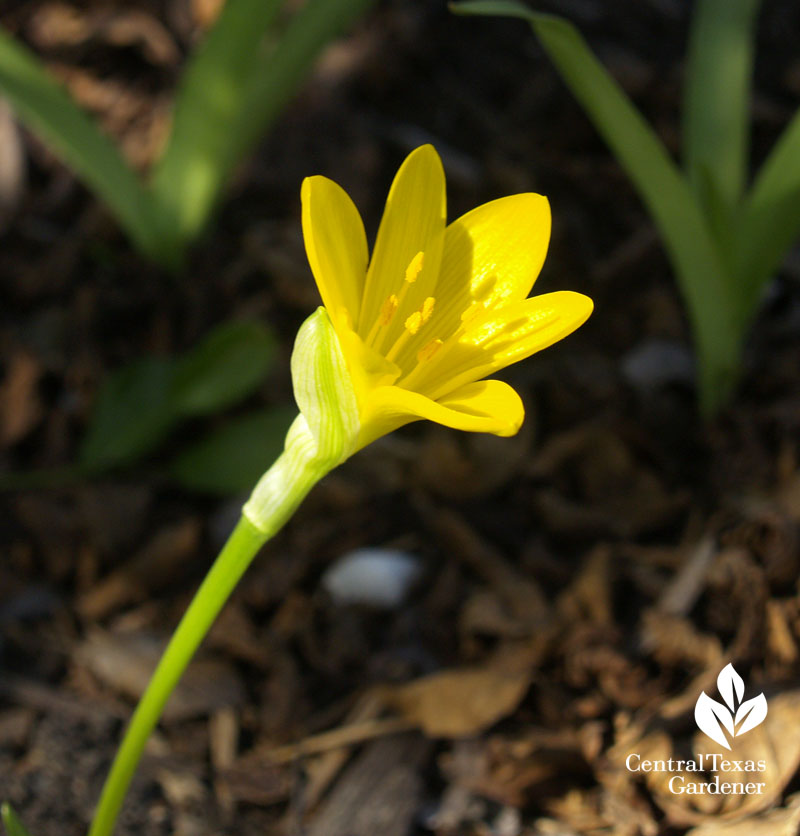September 27, 2012
Fall in love with autumn bulbs and grasses
Big day in my garden! The autumn daffodils (Sternbergia lutea) popped up reliably a year after planting.

These small crocus-like plants, native to the Mediterranean, are cute companions for red oxblood lilies and spider lilies (Lycoris radiata).

Last fall on CTG, Chris Wiesinger, author of Heirloom Bulbs for Today, introduced me to these beauties that will naturalize in my Blackland soil, even in part shade! I wasted no time ordering these hard-to-find bulbs online.
Mostly though, I get plants from local nurseries supplied by local/regional growers (or grown themselves), along with passalongs from friends. My native Plumbago scandens has been in non-stop mode for months against evergreen Texas sedge (Carex texensis). The plumbago will die to the ground this winter but return even stronger next spring.

Mine came from the Lady Bird Johnson Wildflower Center sales—coming up again Oct. 13 & 14 (member’s preview Oct. 12). You can even join that day to beat the rush for superb natives, including ones that don’t often show up in nurseries.
These days, many nurseries do have native grasses like Lindheimer muhly (on the left) and deer muhly (on the right): this spectacular duo in Anne Bellomy’s garden.

Native grasses, in the fields and in our gardens, are both lovely and beneficial. Many send down deep roots, benefiting aeration, stabilizing the soil, and improving fertility—along with providing shelter and food for wildlife. And in fall, they are the ultimate drama queens! My Lindheimer was our favorite autumn standout until it got too much shade and withered away. Until I find a sunny spot, I’ll just enjoy Anne’s.

This week, Tom meets with Shirley and Brian Loflin, who note that grasses once predominated the Hill Country and the Blackland prairie.

Their book, Grasses of the Texas Hill Country, is a friendly hands-on guide to identify and learn about both cool and warm weather grasses in our fields and for our gardens. This popular book is currently in reprint, available for pre-order from Texas A&M University Press.

Currently, it is available as a Google ebook, too.
Brian’s photography helps make it easier to identify the grasses that soon will be in show-off mode, like curly mesquite. This one’s part of the Habiturf mix that includes buffalo grass and blue grama for a native lawn in sun. By the way, the Habiturf trio is available at the Wildflower Center and online.

Little bluestem is another native beauty that you’ll be seeing soon.

Artist Shirley also creates beautiful framed botanicals with grasses, perfect for that wall you’ve wanted to adorn!

You can order online from their site, The Nature Connection, and also find out about their workshops, field trips, and see Brian’s extensive photography of insects, animals, plants, and wonders of the natural world.
Want to know more about cactus, too?!

Since we’re heading into prime time planting season for grasses, shrubs, perennials and wildflowers, get inspired with a visit to Betty & Gerald Ronga’s garden where food, wildflowers and wildlife unite on this rocky hilltop in Leander.

Many of us face watering restrictions, like Sheila C., who asks if fungal disease is a problem if we must water at night.

Daphne explains how it depends on the season and the situation.
It’s hard to imagine that we’re just weeks away from losing our summer annual herbs. Get ready now with Trisha’s tips and tricks for freezing herbs in oil and butter, along with recipes and making herbal vinegars.

Note: to watch an individual segment online, click on the vertical chapter marks above the play bar!
Happy planting and see you next week, Linda
tags:

